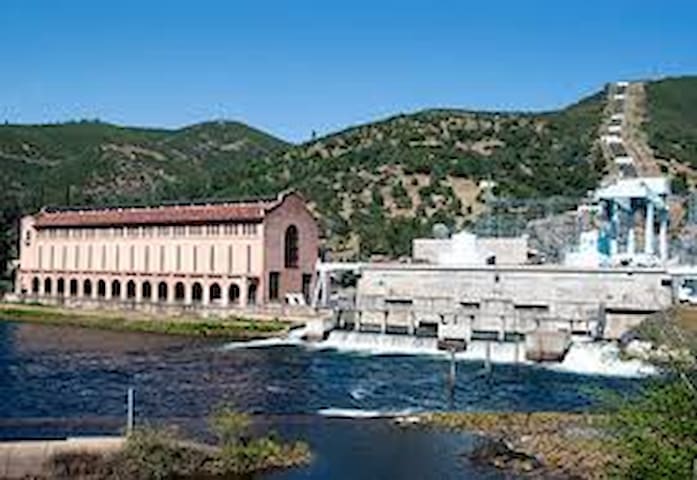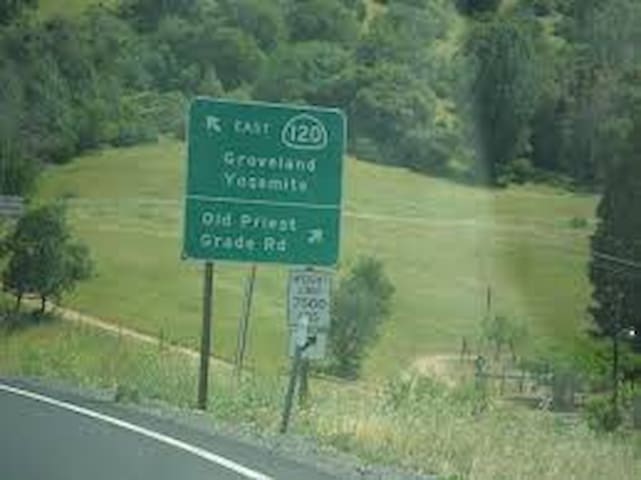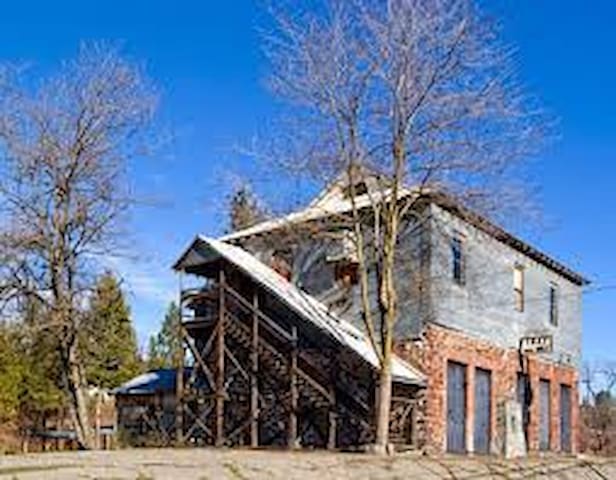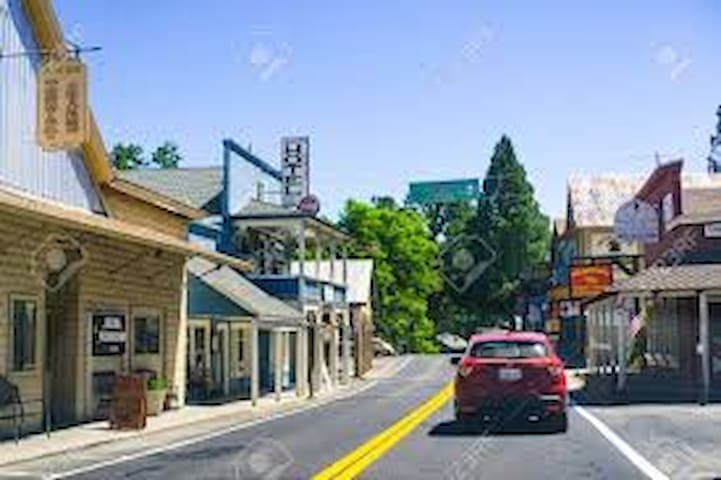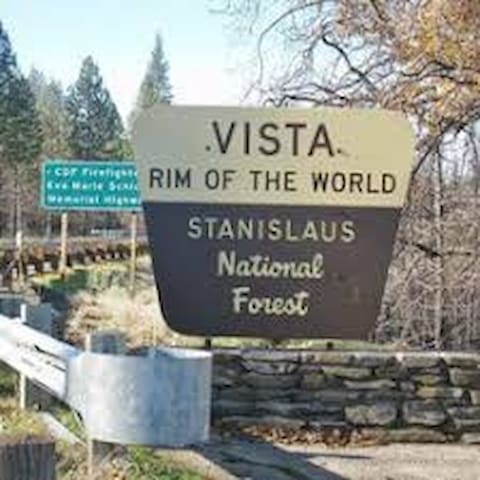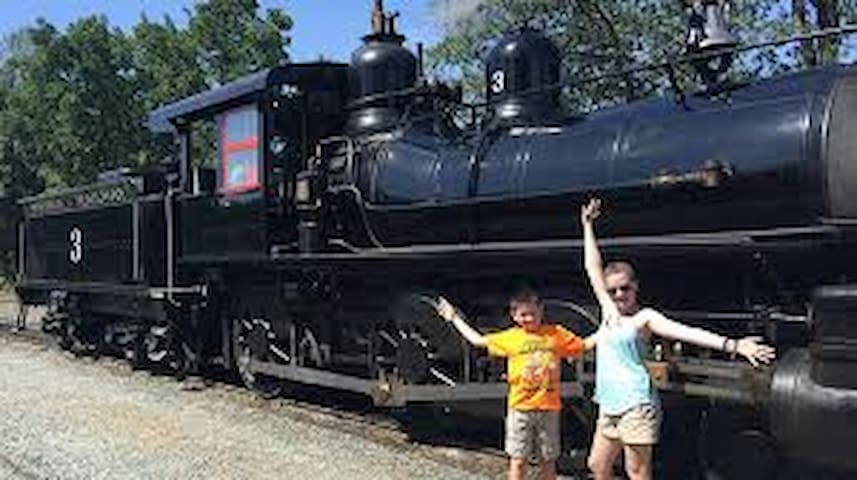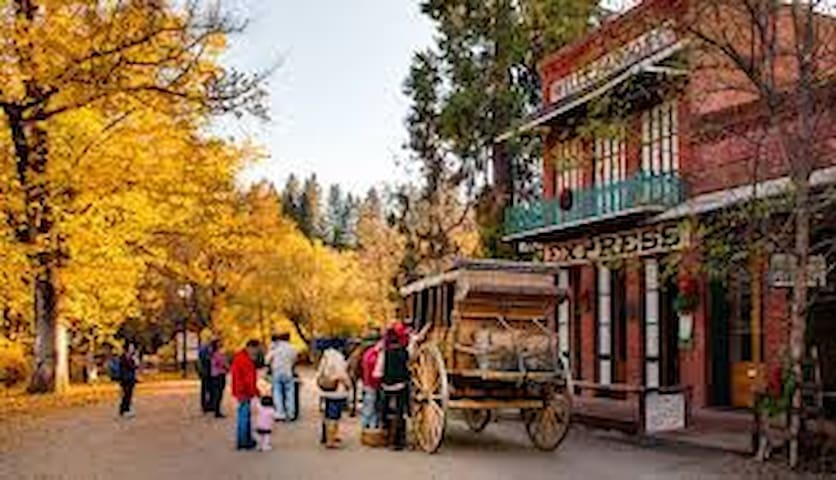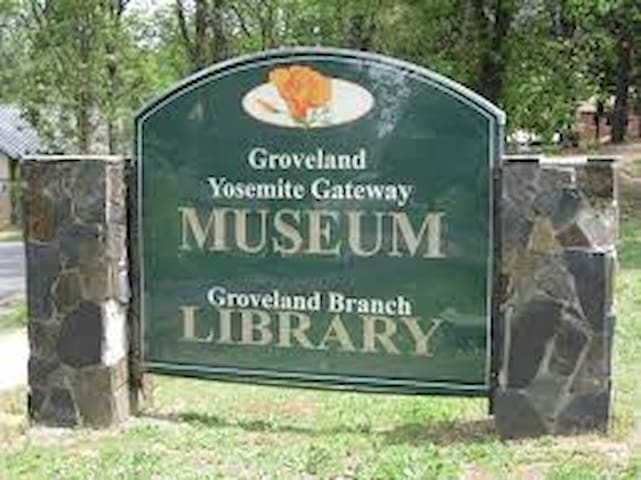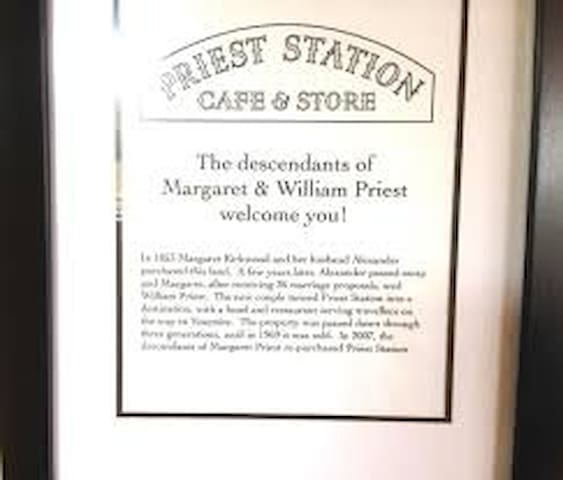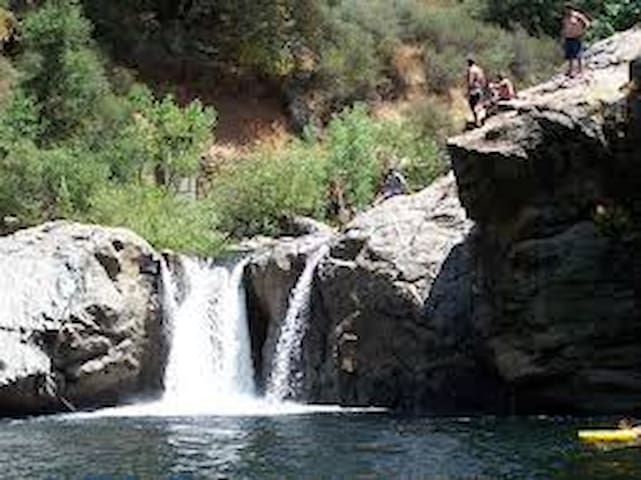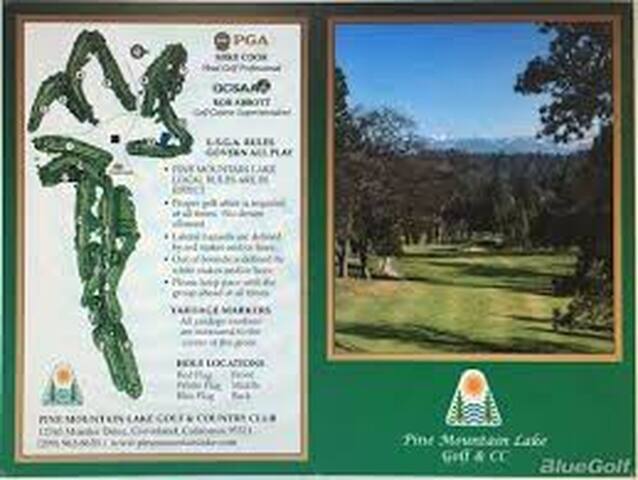Sightseeing
Chinese Camp is the remnant of a notable California Gold Rush mining town. The settlement was first known as "Camp Washington" or "Washingtonville" and one of the few remaining streets is Washington Street. Some of the very first Chinese laborers arriving in California in 1849 were driven from neighboring Camp Salvado and resettled here, and the area started to become known as "Chinee" or "Chinese Camp" or "Chinese Diggings". At one point, the town was home to an estimated 5,000 Chinese.
The Chinese Camp post office was established in the general store on April 18, 1854. This building is currently vacant, and a post office is in operation on a plot of land rented from a local resident.
An 1892 Tuolumne County history indicates that, in 1856, four of the six Chinese companies (protective associations) had agents here and that the first tong war (between the Sam Yap and Yan Woo tongs) was fought near here when the population of the area totaled several thousand. The actual location is several miles away, past the 'red hills', near the junction of Red Hills Road and J-59.
An 1860 diary says Chinese Camp was the metropolis for the mining district, with many urban comforts. While placer mining had played out in much of the Gold Country by the early 1860s, it was still active here as late as 1870. An 1899 mining bulletin listed the total gold production of the area as near US$2.5 million.
June 2014. The Chinese Camp, California Elementary School
Chinese Camp is the location and subject of California Historical Landmark 423 – The Saint Francis Xavier Roman Catholic Church, established in 1849, making it the oldest church in the county. The church was renovated in 1949 by John Nicolini but has since fallen into disrepair. The church itself is owned by the Stockton archdiocese.
The current Chinese Camp School is very distinctive, having been designed by Dolores Nicolini in the style of a Chinese pagoda. This school has been in operation since 1970. Previously, the school was in a building near the church. This building was lost in a fire on May 4, 2006. The fire was caused by carelessness on the part of several local individuals[
Old Chinese Camp Town
10015 Main StreetChinese Camp is the remnant of a notable California Gold Rush mining town. The settlement was first known as "Camp Washington" or "Washingtonville" and one of the few remaining streets is Washington Street. Some of the very first Chinese laborers arriving in California in 1849 were driven from neighboring Camp Salvado and resettled here, and the area started to become known as "Chinee" or "Chinese Camp" or "Chinese Diggings". At one point, the town was home to an estimated 5,000 Chinese.
The Chinese Camp post office was established in the general store on April 18, 1854. This building is currently vacant, and a post office is in operation on a plot of land rented from a local resident.
An 1892 Tuolumne County history indicates that, in 1856, four of the six Chinese companies (protective associations) had agents here and that the first tong war (between the Sam Yap and Yan Woo tongs) was fought near here when the population of the area totaled several thousand. The actual location is several miles away, past the 'red hills', near the junction of Red Hills Road and J-59.
An 1860 diary says Chinese Camp was the metropolis for the mining district, with many urban comforts. While placer mining had played out in much of the Gold Country by the early 1860s, it was still active here as late as 1870. An 1899 mining bulletin listed the total gold production of the area as near US$2.5 million.
June 2014. The Chinese Camp, California Elementary School
Chinese Camp is the location and subject of California Historical Landmark 423 – The Saint Francis Xavier Roman Catholic Church, established in 1849, making it the oldest church in the county. The church was renovated in 1949 by John Nicolini but has since fallen into disrepair. The church itself is owned by the Stockton archdiocese.
The current Chinese Camp School is very distinctive, having been designed by Dolores Nicolini in the style of a Chinese pagoda. This school has been in operation since 1970. Previously, the school was in a building near the church. This building was lost in a fire on May 4, 2006. The fire was caused by carelessness on the part of several local individuals[
A company town, Moccasin is almost entirely owned by the City and County of San Francisco. Homes are used for employees who work on the Hetch Hetchy Water & Power system. Most buildings are painted the same color and homes in the community look similar as a result. There are no stores or gas stations.
Construction on the original Moccasin Powerhouse was started in Fall 1921. The facility was completed and began generating power on August 14, 1925.
6 lokal ang nagrerekomenda
Moccasin
A company town, Moccasin is almost entirely owned by the City and County of San Francisco. Homes are used for employees who work on the Hetch Hetchy Water & Power system. Most buildings are painted the same color and homes in the community look similar as a result. There are no stores or gas stations.
Construction on the original Moccasin Powerhouse was started in Fall 1921. The facility was completed and began generating power on August 14, 1925.
PLEASE NOTE/CAUTION *** "Old Priest Grade is one of the steepest paved roads in Tuolumne County, and some hill-climbing bicyclists believe it’s one of the steepest in the Golden State. Duke York, deputy director for Tuolumne County roads and engineering, said the road is 1.97 miles from bottom to top, with grade steepness up to 18 percent, and the steepest stretch might be closer to 20 percent." per Union-Democrat, a Sonora, CA newspaper. ** PLEASE NOTE/CAUTION
Immediately east of town (Moccasin), State Route 120 climbs from about 910 feet (280 m) AMSL elevation to about 2,450 feet (750 m) at Priest Station, California, over a distance of 4.5 miles (10 km). Old Priest Grade, a narrower road and predecessor to the current route of SR120, covers the same change in elevation over about 1.8 miles (2.9 km). It is common to see vehicles with smoking brakes descending the old grade. During summer, ambient temperatures can be in the 90~100 °F range. In these temperatures, many vehicles overheat climbing the old grade. For this reason, bottles of water are available at turnouts along Old Priest Grade to fill overheating vehicles. A sign on Highway 120 also advises drivers to turn off air conditioning in order to prevent overheating while climbing either grade. Locals tell stories of car accidents in history where the vehicles left the path of Old Priest Grade and tumbled into Grizzly Gulch. The hillsides are sturdy chaparral with thick vegetation. The terrain was so difficult that, in a few cases, the cars and bodies were not retrieved, some locals claim. Construction to widen curves and add guard rails began in July .
Old Priest Grade
PLEASE NOTE/CAUTION *** "Old Priest Grade is one of the steepest paved roads in Tuolumne County, and some hill-climbing bicyclists believe it’s one of the steepest in the Golden State. Duke York, deputy director for Tuolumne County roads and engineering, said the road is 1.97 miles from bottom to top, with grade steepness up to 18 percent, and the steepest stretch might be closer to 20 percent." per Union-Democrat, a Sonora, CA newspaper. ** PLEASE NOTE/CAUTION
Immediately east of town (Moccasin), State Route 120 climbs from about 910 feet (280 m) AMSL elevation to about 2,450 feet (750 m) at Priest Station, California, over a distance of 4.5 miles (10 km). Old Priest Grade, a narrower road and predecessor to the current route of SR120, covers the same change in elevation over about 1.8 miles (2.9 km). It is common to see vehicles with smoking brakes descending the old grade. During summer, ambient temperatures can be in the 90~100 °F range. In these temperatures, many vehicles overheat climbing the old grade. For this reason, bottles of water are available at turnouts along Old Priest Grade to fill overheating vehicles. A sign on Highway 120 also advises drivers to turn off air conditioning in order to prevent overheating while climbing either grade. Locals tell stories of car accidents in history where the vehicles left the path of Old Priest Grade and tumbled into Grizzly Gulch. The hillsides are sturdy chaparral with thick vegetation. The terrain was so difficult that, in a few cases, the cars and bodies were not retrieved, some locals claim. Construction to widen curves and add guard rails began in July .
**Please note, Map shows this way North near Grass Valley, CA. That is not correct. Big Oak Flat is located in Tuolumne County, A short distance from Groveland, CA**
After cresting the grade, you pass through the small town of Big Oak Flat, called “Savage’s Diggings” (after James D. Savage) during the gold rush era. Approximately 1 mile east of Priest Station Cafe on Highway 120. The community of Big Oak Flat was founded by James D. Savage who began mining the area about 1851. Savage is credited as the leader of the first group of non Native Americans of European ancestry into Yosemite Valley in 1851, (March 27, 1851). Others of European ancestry may have seen the valley as early as 1833. From approximately 1916 to 1924, Big Oak Flat served as a staging area and housing location for workers constructing the Hetch Hetchy Railroad which was required to build the O'Shaughnessy Dam on the Tuolumne River in the Hetch Hetchy Valley. Big Oak Flat is now registered as California Historical Landmark #406.
Big Oak Flat
**Please note, Map shows this way North near Grass Valley, CA. That is not correct. Big Oak Flat is located in Tuolumne County, A short distance from Groveland, CA**
After cresting the grade, you pass through the small town of Big Oak Flat, called “Savage’s Diggings” (after James D. Savage) during the gold rush era. Approximately 1 mile east of Priest Station Cafe on Highway 120. The community of Big Oak Flat was founded by James D. Savage who began mining the area about 1851. Savage is credited as the leader of the first group of non Native Americans of European ancestry into Yosemite Valley in 1851, (March 27, 1851). Others of European ancestry may have seen the valley as early as 1833. From approximately 1916 to 1924, Big Oak Flat served as a staging area and housing location for workers constructing the Hetch Hetchy Railroad which was required to build the O'Shaughnessy Dam on the Tuolumne River in the Hetch Hetchy Valley. Big Oak Flat is now registered as California Historical Landmark #406.
Groveland has always been an important stop on the highway to Yosemite but really grew in the early 1900s with the development of the Tuolumne River Hetch-Hetchy water project for the city of San Francisco. Groveland is adjacent to the Stanislaus National Forest and is known for the historic Iron Door Saloon, the gated community of Pine Mountain Lake which boasts its own local newspaper called The Pine Mountain Lake News [2], and the nursery/gallery/general store Mountain Sage.
Groveland was originally a gold rush town and then became a sleepy farming community until the San Francisco Hetch Hetchy water project made it their headquarters and built a railroad yard and hospital for the work crews (both now gone). From 1915 till 1935 Groveland was a boom town supporting seven hotels, 10,000 residents and much activity. When the work crews left the town again became a minor stop on the way to Yosemite until the Boise Cascade company built the Pine Mountain Lake community with a first class golf course, an airport and lake and staked out 5000 lots. This development has since grown from a summer home area to a retirement community to a thriving neighborhood with year-round families, boosting the once sleepy Groveland to a travel and vacation destination in its own right.
Groveland is the main town on the Highway 120 route to Yosemite National Park, and boasts numerous lodging and restaurant businesses. The local Community Park features picnic tables, BBQ pits, a skate park and basketball court area, children's playground, bandstand and lawn seating for music and summer Movies in the Park events, public toilets and parking, and the Groveland Museum and Library. There is free Wireless Internet in the park area, provided by a joint effort between Hotel & Cafe Charlotte and the Groveland Community Services District.
In addition to lodging and eateries, local businesses include a Grocery Market, Pharmacy, Medical Clinic, Emergency Services, Fire Department headquarters, and many boutique gift shops. There are places to buy tire chains in the winter, as well as snow shoes and other winter equipment, plus camping and backpacking supplies during the summer months. Local tour guide companies offer custom "they drive you" trips into Yosemite Valley, and local White Water Rafting companies offer trips on the Tuolumne River nearby.
Tioga High School and Tenaya Elementary School are located in Groveland.
35 lokal ang nagrerekomenda
Groveland
Groveland has always been an important stop on the highway to Yosemite but really grew in the early 1900s with the development of the Tuolumne River Hetch-Hetchy water project for the city of San Francisco. Groveland is adjacent to the Stanislaus National Forest and is known for the historic Iron Door Saloon, the gated community of Pine Mountain Lake which boasts its own local newspaper called The Pine Mountain Lake News [2], and the nursery/gallery/general store Mountain Sage.
Groveland was originally a gold rush town and then became a sleepy farming community until the San Francisco Hetch Hetchy water project made it their headquarters and built a railroad yard and hospital for the work crews (both now gone). From 1915 till 1935 Groveland was a boom town supporting seven hotels, 10,000 residents and much activity. When the work crews left the town again became a minor stop on the way to Yosemite until the Boise Cascade company built the Pine Mountain Lake community with a first class golf course, an airport and lake and staked out 5000 lots. This development has since grown from a summer home area to a retirement community to a thriving neighborhood with year-round families, boosting the once sleepy Groveland to a travel and vacation destination in its own right.
Groveland is the main town on the Highway 120 route to Yosemite National Park, and boasts numerous lodging and restaurant businesses. The local Community Park features picnic tables, BBQ pits, a skate park and basketball court area, children's playground, bandstand and lawn seating for music and summer Movies in the Park events, public toilets and parking, and the Groveland Museum and Library. There is free Wireless Internet in the park area, provided by a joint effort between Hotel & Cafe Charlotte and the Groveland Community Services District.
In addition to lodging and eateries, local businesses include a Grocery Market, Pharmacy, Medical Clinic, Emergency Services, Fire Department headquarters, and many boutique gift shops. There are places to buy tire chains in the winter, as well as snow shoes and other winter equipment, plus camping and backpacking supplies during the summer months. Local tour guide companies offer custom "they drive you" trips into Yosemite Valley, and local White Water Rafting companies offer trips on the Tuolumne River nearby.
Tioga High School and Tenaya Elementary School are located in Groveland.
You get a panoramic view of Jawbone Ridge and the Tuolumne River Canyon from here. Anytime of year, this vista is a great treat. In the winter, the snow covers the trees and sparkles throughout the valley and mountains. In the summer, the green valley, flora and fauna, are all buzzing with excitement. It is always peaceful and sunsets are NOT to be missed.
There are two firefighter memorials here. One is for Eva Schicke: Eva was a crew member of Helitac 404, based out of Columbia, California. On 9/12/2004 the Heltec crew was overrun by flames on the Toulome Fire. The fire was located over the ridge from where you stand, in the Toulomne river canyon. The other is for David Erickson: A US Forest Service crew leader from Siskiyou County, Calif., who lost his life while fighting the Stanislaus Complex Fire which destroyed 147,000 acres
The restroom here is usually very clean, but there is no lighting inside. Also, there is one handicap parking spot close to the restroom.
The parking lot is easy to get off Hwy 120 to park and equally easy to get back on.
Sit for a spell, enjoy the fresh air, enjoy the beautiful view and recoup for your ride to your next adventure.
*On left side of Hwy. 120 approximately 1.4 miles (as the crow flies) from the Rainbow Pool turn off.
Stanislaus National Forest Vista: Rim of the World
California 120You get a panoramic view of Jawbone Ridge and the Tuolumne River Canyon from here. Anytime of year, this vista is a great treat. In the winter, the snow covers the trees and sparkles throughout the valley and mountains. In the summer, the green valley, flora and fauna, are all buzzing with excitement. It is always peaceful and sunsets are NOT to be missed.
There are two firefighter memorials here. One is for Eva Schicke: Eva was a crew member of Helitac 404, based out of Columbia, California. On 9/12/2004 the Heltec crew was overrun by flames on the Toulome Fire. The fire was located over the ridge from where you stand, in the Toulomne river canyon. The other is for David Erickson: A US Forest Service crew leader from Siskiyou County, Calif., who lost his life while fighting the Stanislaus Complex Fire which destroyed 147,000 acres
The restroom here is usually very clean, but there is no lighting inside. Also, there is one handicap parking spot close to the restroom.
The parking lot is easy to get off Hwy 120 to park and equally easy to get back on.
Sit for a spell, enjoy the fresh air, enjoy the beautiful view and recoup for your ride to your next adventure.
*On left side of Hwy. 120 approximately 1.4 miles (as the crow flies) from the Rainbow Pool turn off.
At Railtown 1897 State Historic Park in Jamestown, California, history comes to life with vintage steam trains, a working roundhouse, and the timeless Sierra Railway Shops, a designated California Historical Landmark.
100 lokal ang nagrerekomenda
Railtown 1897 State History Park
10501 Reservoir RdAt Railtown 1897 State Historic Park in Jamestown, California, history comes to life with vintage steam trains, a working roundhouse, and the timeless Sierra Railway Shops, a designated California Historical Landmark.
Gold was discovered in the area that became Columbia on March 27, 1850, and was one of the richest finds of the California Gold Rush. The surface-level deposits were amenable to placer mining, but lacked water needed for such operations. Over the next seven years, a network of water supply aqueducts was built (at a cost of over $1 million) to the area to support mining operations. By 1852, sufficient water was arriving to support the development of a mining boom town, and large-scale mining operations began in 1856. The town was incorporated in 1854, and its population fluctuated in the 1850s between 2,000 and 5,000 people. The town was repeatedly struck by fire, and much of the construction after an 1857 fire was in brick
217 lokal ang nagrerekomenda
Columbia State Historic Park
11259 Broadway StGold was discovered in the area that became Columbia on March 27, 1850, and was one of the richest finds of the California Gold Rush. The surface-level deposits were amenable to placer mining, but lacked water needed for such operations. Over the next seven years, a network of water supply aqueducts was built (at a cost of over $1 million) to the area to support mining operations. By 1852, sufficient water was arriving to support the development of a mining boom town, and large-scale mining operations began in 1856. The town was incorporated in 1854, and its population fluctuated in the 1850s between 2,000 and 5,000 people. The town was repeatedly struck by fire, and much of the construction after an 1857 fire was in brick
In the 1950’s, several smaller and older fish hatcheries, operated by the California Department of Fish and Game, were closed and hatchery operations moved to larger more efficient operations. The Basin Creek (Tuolumne), Yosemite, Bass Lake (Madera), Kings River and Visalia hatcheries were closed and replaced by the new San Joaquin Hatchery (on the San Joaquin River) and the Moccasin Creek Hatchery
Moccasin Creek Hatchery
In the 1950’s, several smaller and older fish hatcheries, operated by the California Department of Fish and Game, were closed and hatchery operations moved to larger more efficient operations. The Basin Creek (Tuolumne), Yosemite, Bass Lake (Madera), Kings River and Visalia hatcheries were closed and replaced by the new San Joaquin Hatchery (on the San Joaquin River) and the Moccasin Creek Hatchery
Groveland Yosemite Gateway Museum
18990 CA-120https://grovelandmuseum.org/
Food scene
Now in its sixth generation of family ownership, Priest Station has a long and interesting history. Originally a miner’s supply store, it was purchased by Margaret & Alexander Kirkwood in 1853. A few years later, Alexander passed away and left Margaret a young widow. She received 36 marriage proposals and chose Wm. Priest, Yosemite’s first Park Commissioner and an engineer responsible for the Big Oak Flat Road (now Hwy 120) as well as Tioga Pass.
Under the Priests’ ownership the property became a stagecoach stop and 22 building hotel complex known for its hospitality, accommodations and table. In 1926, a fire destroyed everything except the well, which still stands today and is the only structure remaining from the 1800s. A few years after the 1926 fire, a new house was built for the next generation of family owners, gradually adding four cabins in the 1940s. This house stood near the roadside and had a front parlor where the public could be served.
Cabins, 1940s
In 1969 the property was sold and run by various non-family owners who made changes to the property, including the conversion of one cabin into a restaurant after the 1920s front house burned down in the 1980s. Priest Station was re-acquired in 2007 by the Anker Family, the 4th, 5th and 6th generation descendants of the original Priest Family founders. After undergoing complete renovations, Priest Station Cafe opened in August 2009.
42 lokal ang nagrerekomenda
Priest Station Café
16756 Old Priest GradeNow in its sixth generation of family ownership, Priest Station has a long and interesting history. Originally a miner’s supply store, it was purchased by Margaret & Alexander Kirkwood in 1853. A few years later, Alexander passed away and left Margaret a young widow. She received 36 marriage proposals and chose Wm. Priest, Yosemite’s first Park Commissioner and an engineer responsible for the Big Oak Flat Road (now Hwy 120) as well as Tioga Pass.
Under the Priests’ ownership the property became a stagecoach stop and 22 building hotel complex known for its hospitality, accommodations and table. In 1926, a fire destroyed everything except the well, which still stands today and is the only structure remaining from the 1800s. A few years after the 1926 fire, a new house was built for the next generation of family owners, gradually adding four cabins in the 1940s. This house stood near the roadside and had a front parlor where the public could be served.
Cabins, 1940s
In 1969 the property was sold and run by various non-family owners who made changes to the property, including the conversion of one cabin into a restaurant after the 1920s front house burned down in the 1980s. Priest Station was re-acquired in 2007 by the Anker Family, the 4th, 5th and 6th generation descendants of the original Priest Family founders. After undergoing complete renovations, Priest Station Cafe opened in August 2009.
The Historic Iron Door Saloon is the oldest continuously operating saloon in California. Located near Yosemite National Park, it was built in the California Gold Country sometime before 1852. It was first called the "Granite Store", perhaps because the front and back walls are made of solid granite blocks. The sidewalls are made of "shist" rock and mortar and the roof consists of three feet of sod, covered by tin.
James Tannahill was the first owner of the store that would become the Iron Door Saloon and served the Groveland community as the first Postmaster from 1863 to 1880, running the post office in the store.
The establishment became a saloon in 1896 when it was purchased by Giacomo DeFarrari and was named "Jake's Place."
In 1937 a second story was added and cards, billiards and pool were offered for an evenings diversion. The establishment was renamed "The Iron Door Saloon" after the hefty iron doors which had been hauled in on mule back across the Tuolumne River by way of Wards Ferry. These iron doors were manufactured in England and brought around the tip of South America by sailing ship and sold to the saloon as a fire protection device. The idea was that if the town was burning, you just shut the doors and waited it out.
The iron doors on the front of the saloon today are the same ones originally fitted. Inside, you will be treated to a page from history. In addition to some stray bullet holes, you'll find the finest looking back bar in the Yosemite area, historic pictures of Hetch Hetchy in pre-O'Shaughnessy Dam days, and many antique gold mining, timber and farm implements of the old West.
You'll also see historic pictures of John Muir, the founder of the Sierra Club, and spectacular scenery of Yosemite Valley. There is a tribute to Black Bart, the famous "Gentleman Stage Coach Robber", and a natural history museum of indigenous animal species of the Sierra Nevada and their status in the wild.
The Iron Door Saloon receives guests from all over the world, passing through on their way to Yosemite National Park. Children are welcome to peruse the unique collection of artifacts.
122 lokal ang nagrerekomenda
Iron Door Store
18752 Main StThe Historic Iron Door Saloon is the oldest continuously operating saloon in California. Located near Yosemite National Park, it was built in the California Gold Country sometime before 1852. It was first called the "Granite Store", perhaps because the front and back walls are made of solid granite blocks. The sidewalls are made of "shist" rock and mortar and the roof consists of three feet of sod, covered by tin.
James Tannahill was the first owner of the store that would become the Iron Door Saloon and served the Groveland community as the first Postmaster from 1863 to 1880, running the post office in the store.
The establishment became a saloon in 1896 when it was purchased by Giacomo DeFarrari and was named "Jake's Place."
In 1937 a second story was added and cards, billiards and pool were offered for an evenings diversion. The establishment was renamed "The Iron Door Saloon" after the hefty iron doors which had been hauled in on mule back across the Tuolumne River by way of Wards Ferry. These iron doors were manufactured in England and brought around the tip of South America by sailing ship and sold to the saloon as a fire protection device. The idea was that if the town was burning, you just shut the doors and waited it out.
The iron doors on the front of the saloon today are the same ones originally fitted. Inside, you will be treated to a page from history. In addition to some stray bullet holes, you'll find the finest looking back bar in the Yosemite area, historic pictures of Hetch Hetchy in pre-O'Shaughnessy Dam days, and many antique gold mining, timber and farm implements of the old West.
You'll also see historic pictures of John Muir, the founder of the Sierra Club, and spectacular scenery of Yosemite Valley. There is a tribute to Black Bart, the famous "Gentleman Stage Coach Robber", and a natural history museum of indigenous animal species of the Sierra Nevada and their status in the wild.
The Iron Door Saloon receives guests from all over the world, passing through on their way to Yosemite National Park. Children are welcome to peruse the unique collection of artifacts.
Cocina Michoacana is a very humble and cute Mexican restaurant set right in the heart of Groveland. Comforting and delicious Mexican food.
74 lokal ang nagrerekomenda
Cocina Michoacana
18730 Main StCocina Michoacana is a very humble and cute Mexican restaurant set right in the heart of Groveland. Comforting and delicious Mexican food.
For over 30 years, Pizza Factory has stayed true to its roots. Hardworking owners and staff , family - friendly dining, and a high- quality product make them the best pizza in town.
56 lokal ang nagrerekomenda
Pizza Factory
5005 5th StFor over 30 years, Pizza Factory has stayed true to its roots. Hardworking owners and staff , family - friendly dining, and a high- quality product make them the best pizza in town.
The Mar Val Food Stores management and staff are dedicated to providing you with the finest quality grocery items along with excellent customer service. We have been serving local communities for over 60 years Thank you for your continued support.
Groveland
1900 Main St, Groveland, CA 95321 (209) 962-7452
82 lokal ang nagrerekomenda
Mar-Val
19000 Main StThe Mar Val Food Stores management and staff are dedicated to providing you with the finest quality grocery items along with excellent customer service. We have been serving local communities for over 60 years Thank you for your continued support.
Groveland
1900 Main St, Groveland, CA 95321 (209) 962-7452
Black Oak Casino
Black Oak Casino.
Round out your stay by visiting our casino for casual and fine dining, gaming and endless entertainment for all ages. Plus, we’re ideally located near Yosemite National Park and historic Gold Country!
Black Oak Casino is located approximately 30 miles and 55 minutes from the cabin. Please check link below for details:
www.blackoakcasino.com
155 lokal ang nagrerekomenda
Black Oak Casino Resort
19400 Tuolumne Rd N Round out your stay by visiting our casino for casual and fine dining, gaming and endless entertainment for all ages. Plus, we’re ideally located near Yosemite National Park and historic Gold Country!
Black Oak Casino is located approximately 30 miles and 55 minutes from the cabin. Please check link below for details:
www.blackoakcasino.com
Boating, Fishing, Swimming, Camping
http://zrafting.com/
Moccasin Point Marina
11405 Jacksonville RoadRainbow Pool
California 120ARTA River Trips
6 South Washington Streethttps://www.arta.org/
Sierra Mac River Trips
27890 CA-120Zephyr Whitewater Merced Office
6940 CA-140Golf/Country Club
Pine Mountain Lake Golf Course
12765 Mueller Drhttps://www.pinemountainlake.com/


